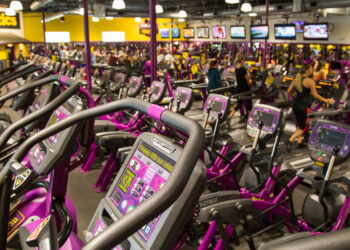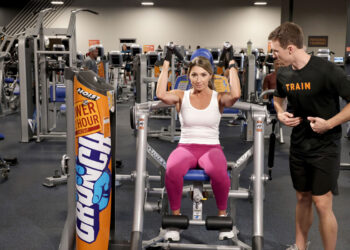By: Tyler Montgomery
 When some club owners hear the terms “remanufactured,” “refurbished” or “used” equipment they tend to shut down. However, second-hand equipment can often help clubs gain an advantage over the competition by lowering overhead. In turn, this can free up resources, allowing clubs to focus on what really brings in the revenue – members!
When some club owners hear the terms “remanufactured,” “refurbished” or “used” equipment they tend to shut down. However, second-hand equipment can often help clubs gain an advantage over the competition by lowering overhead. In turn, this can free up resources, allowing clubs to focus on what really brings in the revenue – members!
Using remanufactured equipment where it makes sense for your club can completely change your budget. This can give owners more freedom to redefine their clubs and become even more competitive in programming and/or other member services. Steve Paterson, vice president of Sales at UsedGymEquipment.com, believes that using this additional cash flow to focus on members and people throughout the club – employees and trainers included – can also help many clubs combat attrition.
REPUTATION AND QUALITY
One of the most important things to know when it comes to purchasing second hand equipment is the level of care that has been put into the product following its use by the original owner. According to Mark Clayton, president of Fitness Equipment Source, the biggest challenge in purchasing remanufactured equipment can be finding a company you’re comfortable working with. “If you only go after price, you will most likely get what you pay for,” he says.
Club owners have good reason to be cautious. Used equipment is sometimes picked up by a low-level dealer, then quickly re-sold to another club as “remanufactured” with little more than a thorough cleaning. “There are many definitions of “remanufactured” equipment in the marketplace today,” says Chris Creighton, vice president of sales and marketing for Atlas Fitness Systems. “The customer should get a clear definition and understanding at the outset of exactly what work will be performed on a unit, and what to expect as a final product.” Clubs may not realize the lack of care in the equipment until it’s in their club and starts breaking down. “Always ask for the maintenance history of the equipment and attempt to purchase newer-model equipment that was in a low-use environment like a corporate center or newer club that had to close,” says Dal Clayton, COO of Titan Fitness.
Graham Bertrand, managing director of the PTE Group, says the most common challenge for club owners is determining the extent to which equipment has been updated. “It can be difficult to tell, but equipment that is properly updated will have gone through a stringent process.” Bertrand says legit remanufacturers will often sell equipment as certified pre-owned to demonstrate this. Creighton advises club owners to look for a credible manufacturer who has a good reputation, acts with integrity and delivers a functional product that meets the promised expectations. According to Paterson, a great way to learn about a company is to travel to the company’s warehouse and see the process first hand – a route many reputable companies will encourage. Some remanufacturers will also take the time to visit gyms and will work together with club owners to ensure they purchase what they really need.

In the remanufactured market, cardiovascular machines often struggle compared to other items. But that doesn’t mean all used cardio equipment should be avoided. Brent Polos, president of Aspen Athletic Club in Syracuse, N.Y., says he purchased four treadmills in 2004 that still work great. Polos contends that the majority of issues associated with cardio equipment originate from a lack of maintenance. “On a weekly basis, we have our staff go through and thoroughly clean the machines,” Polos says. “If you don’t have a preventive maintenance plan, you risk shortening the life span of equipment.”
In 2004, Polos opened a second club in Heath, Ohio and stocked it with around 80 percent remanufactured equipment. “We’ve saved about $100,000 since we opened,” he says. “We don’t cut corners, we just try and save money where it makes sense so we can focus on helping our members get great results.” Polos credits the time he spent researching dealers to his success, adding that he’s never had a member question the equipment. Mark Clayton agrees; in addition to his work with Fitness Equipment Source, he owns Summit Fitness – a club in Sierra Vista, Ariz. that he says is completely stocked with remanufactured equipment. “The members have no idea,” he shares.
“When you’re dealing with strength equipment, I don’t think it really matters if the equipment is remanufactured,” says Pete Daugherty, head of facilities operations for Gainesville Health and Fitness Centers. “A bench is a bench as a plate is a plate. It is all going to do the same thing regardless of whether or not it’s remanufactured – it just needs to look good and function properly.”
Refurbishing specific parts of equipment can also help club owners save a little cash and make their clubs look great. “We are in the process of having all of our plate loaded strength equipment refurbished and repainted,” says Erica Smith, the facilities director for Gainesville Health and Fitness. “When we get the pieces back, they look completely different. Our members immediately notice the upgrades upon entering the area.” These small upgrades help members respect their clubs and can even encourage them to invite friends.
Many reputable used equipment companies also have great working relationships with the manufacturers themselves – some even get their used equipment from lease agreements and other trade-ins. This gives remanufacturers a deeper understanding of the products and allows them to adjust their remanufacturing as needed to make sure the used equipment is solid for club owners. Many reputable remanufacturers also understand how new products are developed. This insight allows them to rebuild motors in treadmills and replenish even the smallest nuts and bolts to make the equipment practically like new.
SAVING YOUR CLUB MONEY
There is currently a very strong inventory of high quality, slightly used equipment available due to start up business failures and repossessions in the tough economy, making it even easier for clubs to upgrade older equipment. Members will recognize and benefit from a reinvestment in the club, and are more apt to continue their memberships if you are able to offer the newest and most popular options.
Remanufactured equipment allows many gym owners to purchase name brand items at a lower cost. In fact, Paterson says clubs can often save between 40 and 70 percent off the original price by going with remanufactured equipment, adding that stationary bikes can be a great place to start. According to Paterson, most stationary bikes don’t have the same wear and tear as many other types of cardio equipment. Bikes tend to lose vibrancy in their paint jobs and often show wear on the seats, but these areas can easily be touched up or replaced, allowing them to provide the same results as new products, only at a cheaper price.
“Most gyms can benefit from purchasing remanufactured equipment,” Dal Clayton shares. He says club owners purchasing equipment for a new gym could save from $50 thousand to $100 thousand of their total equipment budget by purchasing between 20 and 25 percent remanufactured, depending on the size of the club. He adds that club owners who are replacing equipment in an existing gym can often save between 50 and 60 percent of the total cost by choosing remanufactured equipment options.
To give club owners additional peace of mind, Paterson offers product warranties that range from one to three years. With each additional year of the warranty, the price of the remanufactured product increases. The average warranty period is typically around 90 days, with a year sometimes offered on motor maintenance. Chuck Rogers, president of Full Circle Padding, adds that new padding and upholstery should last a club between nine to 10 months. While padding really shouldn’t have problems before that time period, Rogers’ company still offers a 90-day, no-questions-asked warranty. “Replacing pads makes equipment look new and is cheaper than buying new equipment,” he says.
No matter how you use it, the key to success in purchasing remanufactured equipment is most often found in the research you do. No club should walk blindly into purchasing remanufactured equipment; use online tools and talk to other clubs that have already gone down a similar path. The outcome can prove to be a solid business move. Focus on finding a reputable remanufacturer – someone you can trust – and use them to save money. -CS
Remanufactured Equipment 101
Profit: “When selling equipment to used equipment dealers, you might not make a profit. What you will do, however, is minimize the loss on disposal when it hits your financials,” says Jo Rocket, director of fitness services at Town Sports International.
Reputation: Make sure the company you purchase remanufactured equipment from is reputable. Look for warranties, do your research online and visit their home base if you can.
Maintenance: Maintenance can be the difference between equipment that lasts forever and equipment that malfunctions quickly – especially when it comes to cardio machines. Set time aside each week for your staff to clean each piece of equipment in your club.
Be Aware: “Most companies will have a code installed to show you usage for each machine. Looking at this will give you a good idea of the condition the machine is really in – just like an odometer on a vehicle. To play it safe, avoid machines with high usage and obvious mixing of parts from a variety of other machines,” says Erica Smith, facilities director at Gainesville Health and Fitness.
Savings: According to Jim Steenbergen, owner of First Fitness Equipment, club owners who use remanufactured equipment can save between 30 and 50 percent, depending on the type and quantity of equipment they are considering.
Renew: For club owners who decide to go with remanufactured equipment, Brent Polos, president of Aspen Athletic Club, says to keep in mind that many successful clubs purchase newer equipment about every five years. At that time, general maintenance on existing equipment often becomes a real concern, and members are ready to see where their membership dollars are going.
INDUSTRY RESOURCES:
Atlas Fitness Systems
First Fitness Equipment
Fitness Equipment Source
www.fitnessequipmentsource.com
Full Circle Padding
The PTE Group Ltd.
Used Gym Equipment









Glad to see the health club industry is encouraging the purchase of remanufactured / refurbished equipment.
While your article focuses on one very important green factor (saving money) it misses another equally important green factor (saving the earth’s resources). I’m sure your current members would be happy to hear that their club is reducing its carbon footprint by purchasing remanufactured equipment! And perhaps this new green purchasing strategy might help you attract a new batch of eco-minded members.
Either way, we’re happy to see that the mindsets in the health club industry are shifting towards economically and environmental preferable purchasing policies.
– Reuse Alliance
fitness equipments that are chrome plated and using ABS plastics are very common these days coz they are much better ‘